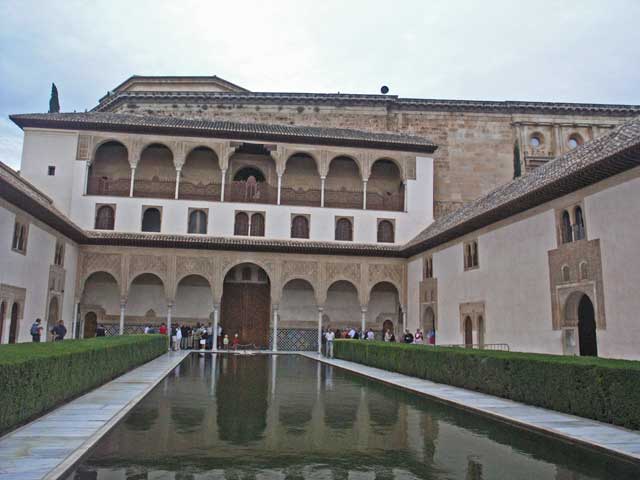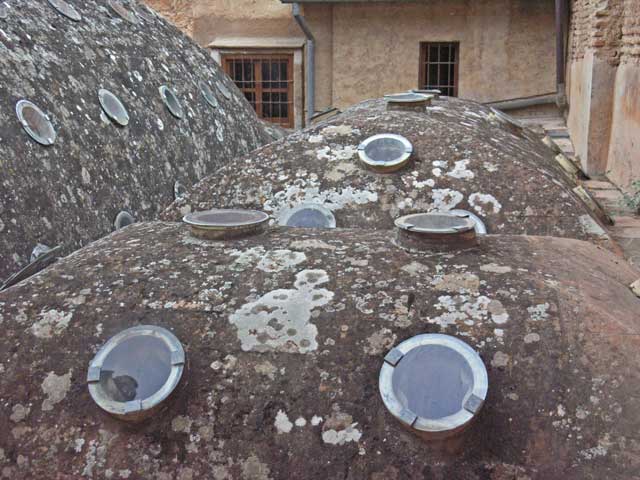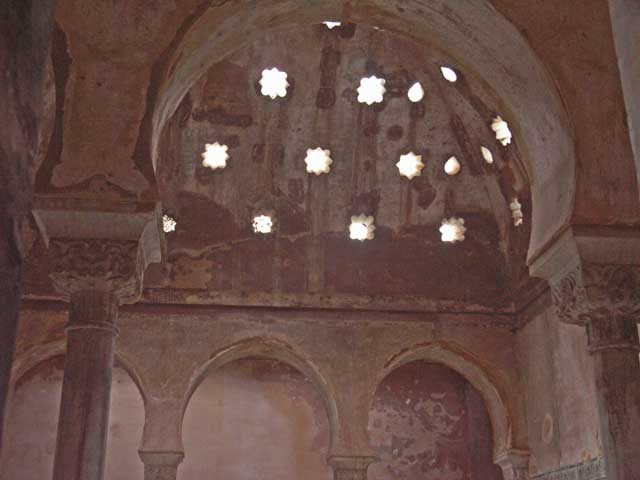
The view back from the path up the hill to the Albaycín. The church at the top of the hill is the Iglesia de San Nicholas.

After dinner at the Santa Paula last night, we started repacking in anticipation of meeting up with the Country Walkers. We both didn’t sleep too well (again). I think I dropped off around 0300 for only three hours sleep. Regardless, I was feeling reasonably rested when my alarm went off at 0600, followed by a minute the wake up call we had arranged earlier. We spotted and met several of our walking companions at breakfast.
After bringing down our bags, our guides, Nick Law and Bruno Lernout arrived and made arrangements to leave everyone’s bags at the hotel until the afternoon. Nick also directed us to bring rain gear as the weather, which was so nice yesterday, had turned threatening. I opted to leave my polar-tek jacket behind, but carried my rain jacket along with my camera.
We walked through the Albaycín (local pronunciation sounds like al-ba-THAYN). Apparently Castillean (Spanish) pronounces certain “c”s with the “th” sound, so Barcelona is pronounced “bar-tha-low-na.” We didn’t dive into the old Muslim quarter, but made for the Rio Darro and walked upstream, crossing the river and climbing the hill along the north side of the citadel. I was perspiring by the time we reached the top where we were to meet our guide who would take us through the Alhambra and Generalife. I recovered quickly and wasn’t too winded – which was a relief. Given the cold I had a couple of weeks ago, our training regimen had suffered. Jonathan commented about being glad that we had been walking the previous two days just to get us ready.
Our guide, Geraldo, took us through the medina (town) to the palace of Charles V which was built abutting the palace of the Muslim rulers. It’s a curious building – perfectly square with a circular courtyard in the exact center. Ironically it was never completed as Charles’ successor moved the capital to Madrid, plus the expulsion of the Moors essentially eliminated the workforce that was building it. The columns are made of a sedimentary rock called puddingstone, which looks a lot like a mélange of small rounded stones in concrete. The columns on the first floor were Doric, the second floor were Ionic, and the plan would have been for the third floor columns to be Corinthian and the large round courtyard would’ve been covered by a dome. Because it was never finished – the windows were never glazed – the palace was never furnished and no one ever lived there (well, no royalty ever lived there). The space in currently used as a museum and office space, the single paned windows on the exterior give the building a rather modern cast.
From there, we went around the corner to the palace of the Nasrids.
The palace is an architectural delight with courtyards, pools, fountains, and the molded plaster decorations for which the Alhambra is famous. There were numerous tile patterns throughout that I kept snapping pictures of. From there we walked through the ruins of the other palaces on our way back out the gate and headed to the Generalife for an encore visit. Geraldo pointed out that the current plantings in the gardens represent a Renaissance mentality. During Islamic rule, the gardens would have been dominated by aromatic plants such as jasmine, rosemary, thyme, oregano, and citrus trees. He also pointed out that the arching row of fountains was a later addition. The Moorish concept of water in the garden is more subtle, producing a quiet sound unlike those fountains which were quite noisy. Geraldo also pointed out that all the fountains and water features were completely gravity driven.

The view back from the path up the hill to the Albaycín. The church at the top of the hill is the Iglesia de San Nicholas.

Looking back towards te Palace of Charles V. The entry was at the far right hand corner of the courtyard.

These are the exteriors of the vaults over the baths. The openings were used to control the temperature.

The inside of the baths - the lights in the ceiling are the openings used to control the temperature.
Another piece of engineering was the sanitation in that every home, including soldiers' and craftsmen's, had running water toilets. The flow from these were collected and directed back to the Rio Darro downstream of the municipal water supply.
From the citadel, we walked down to our restaurant that looked south over Granada and the fertile vega. Most folks had fish – I had turbot which was quite nice. We walked down the hill to our hotel in the rain, where we gathered our bags and boarded the bus to Bubión.
The bus took us south across the plain and into the mountains. The road became more precarious as we left the highway and the road began to rise into the Alpujarra range. The precariousness of the roads only got worse and I spent a certain amount of time assiduously studying the side of the road to avoid looking at all that empty space ahead of the bus.
We pulled into our hotel and got settled into our rooms. We went into the bar and tried to catch up on the diaries, but only got so far before we headed off to dinner. Dinner was at a local establishment however the food was unremarkable. When we got back and hit the sack, I got my best night sleep so far on the trip.
